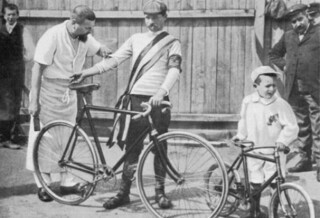Mechanical Doping
Jon Day
Professional cycling has always been populated by cheats, and in the early years of the sport some of their methods were almost comically baroque. The winner of the 1904 Tour de France, Maurice Garin (who'd won the year before, too), was later disqualified for taking a train between stages. Several other riders were caught being towed along by cars, holding corks in their teeth attached to long wires (they could spit them out when they passed potential witnesses).
Most fans have accepted that doping has always been, and will continue to be, a part of professional cycling. But recently, perhaps because of increasing scrutiny from cycling’s governing body the UCI, there have been suggestions that riders have rediscovered an older way to cheat.
Last month the first confirmed case of modern ‘mechanical doping’ was uncovered in a professional race. The bike of the Belgian cyclocross rider Femke Van den Driessche was investigated after it developed a mechanical problem on the course. Inspectors found a small motor hidden in the bike’s bottom bracket, where the cranks join the frame, connected to a series of wires running up under the saddle and on to the handlebars.
Rumours of mechanical doping in the professional peloton have been circulating for years. In 2010, two journalists demonstrated a bicycle with an electric motor hidden in its bottom bracket, which they said had been given to them by a mechanic who had supplied similar bikes to professional racers.
In 2014, a video surfaced showing Eric Ryder Hesjedal fall off his bike. His back wheel appeared to start revolving on its own, after having first come to a stop. The physics certainly appears counter-intuitive, but it’s impossible to read videos such as this with any degree of certainty. Bicycles are curious machines, and often behave strangely. But legions of cycling fans have gone through footage of Van de Driessche’s races with a forensic – or obsessive – eye, slowing down the footage in the hope of isolating the moments she might have pressed a secret button on her handle bars.
It seems that in the world of mechanical doping, Van den Driesseche’s bike (if it was hers; she says it was a friend’s) was something of an out-dated model. Nowadays, according to the Gazzetta dello Sport, mechanical doping is even more sophisticated, using electromagnetic wheels which are almost undetectable. It isn't a cheap way to win: the Gazetta says the wheels can cost up to €200,000.
One way to overcome mechanical doping would be to go back to the old days of the grand tours, when the bikes were supplied by the organisers, and all repairs had to be carried out by the riders themselves. But bike manufacturers, still the main sponsors of professional cycling, would no doubt have something to say about that.

Comments
Ryder Hesjedal, surely?